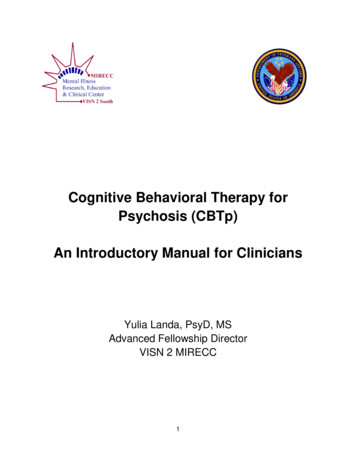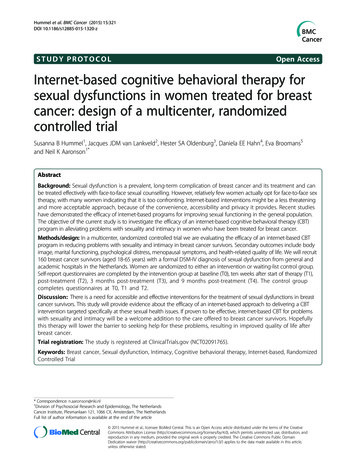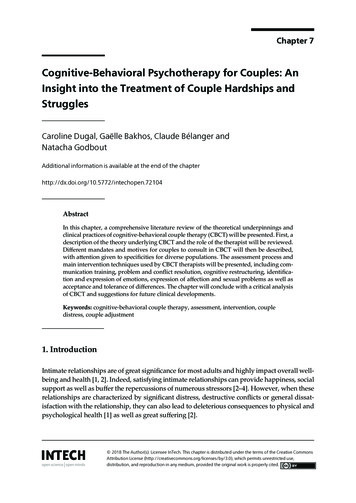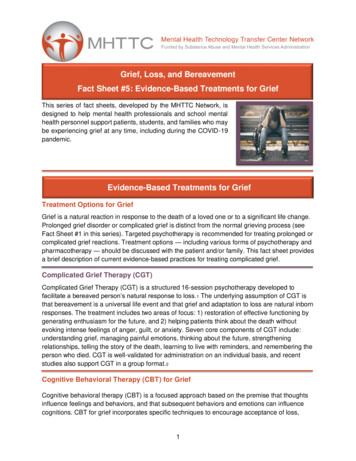
Transcription
Cognitive Behavioral Therapy forPsychosis (CBTp)An Introductory Manual for CliniciansYulia Landa, PsyD, MSAdvanced Fellowship DirectorVISN 2 MIRECC1
ContentsI. IntroductionPage 3II. ModulesPage 4A. Overview of CBTp and Therapeutic TechniquesPage 4B. Working with DelusionsPage 15C. Working with HallucinationsPage 19D. Group Intervention for Delusions and VoicesPage 21E. Working with Thought Disorder and NegativeSymptomsPage 22III. Summary and ApplicationsPage 24IV. Further ReadingsPage 25V. ReferencesPage 262
INTRODUCTIONThis manual provides clinicians with an introductory knowledge of Cognitive Behavioral Therapyfor Psychosis (CBTp). Developed as a companion to training workshops, it has been created asa reference for mental health professionals as they learn foundational theories and techniquesof CBTp, an evidence-based psychological treatment for individuals suffering from psychoticdisorders and symptoms. This manual provides information about the history and developmentof CBTp, clinical research and evidence base for the treatment, and techniques for applyingCBTp in individual and group formats to core psychotic symptoms, including delusions,hallucinations, negative symptoms, and thought disorder. At the end of the manual, users willfind selected readings and references to deepen their knowledge of CBTp.This manual is intended as a guide for clinicians who are interested in learning about CBTp as atreatment modality for their patients with psychotic symptoms and disorders. The goal of themanual is to provide VA clinicians with a secure knowledge base in CBTp so that they can feelconfident in their ability to identify patients who may benefit from CBTp, provide informationabout the treatment to patients and other clinicians, and make appropriate referrals to existingCBTp services. This manual can also serve as an entrée into CBTp for clinicians who may wishto pursue further training in the CBTp and eventually provide CBTp services. It is important tonote that CBTp is a more than just a collection of strategies or techniques, and is rather acomprehensive psychological treatment approach comprised of (1) a comprehensive theory ofpsychopathology and (2) a detailed description of and guide to therapeutic techniques related tothis model (Beck, 1976, 2009). Clinicians who wish to practice CBTp must therefore undergofurther training than this manual can provide, so that they can become proficient in CBTp caseformulation and treatment approach. That said, the hope is that this manual will provide valuableinformation to clinicians working with patients with psychotic disorders, as well as new insightsand perspectives on the nature and treatment of psychotic symptoms. Clinicians who have beenintensively trained in CBTp and those who are currently providing CBTp services may also findthis manual useful as a reference point, guide, and refresher to their previous training. Thosewho are interested in learning more about CBTp, training opportunities for CBTp clinicians, andCBTp services in the VA System should contact: Yulia Landa, PsyD, MS, CBTp ProgramDirector, or Rachel Jespersen, LMSW, CBTp Program Coordinator.3
TRAINING MODULESThis manual is organized into five topic-areas, or modules of study, which align with introductorytraining workshops for clinicians in CBTp. In the first module, information about thedevelopment, research base, underlying theories, and therapeutic techniques is presented. Thesecond module provides information about CBTp theory and techniques for working withdelusions and the third provides information about working with hallucinations. The fourthmodule expands on these topics by providing information about CBTp group protocols to treatdelusions and hallucinations. The fifth module covers treating negative symptoms and thoughtdisorder with CBTp.A. Overview of CBTp and Therapeutic TechniquesA1. History of CBTp and Current StateCognitive Behavioral Therapy for Psychosis(CBTp) is an evidence-based treatmentapproach shown to improve symptoms andfunctioning in patients with psychoticdisorders. CBTp aims to enhance functiondespite difficult symptoms and experiencessuch hallucinations, negative symptoms,thought disturbances, and delusions. CBTpforms a collaborative treatment alliance inwhich patient and therapist can exploredistressing psychotic experiences and thebeliefs the patient has formed about theseexperiences, with the goal of reducing Figure 1: Aims of CBTpdistress and disability caused by theseexperiences. CBTp is a structured, time-limited, and goal-based treatment modality. CBTp canbe delivered in individual and group modalities, has long-lasting benefits after the termination oftherapy, and is cost effective.CBTp was developed by Dr. Aaron Beck, an American psychiatrist who is largely regardedas the father of Cognitive Behavioral Therapy. The first documented application of CBT topsychotic symptoms was Beck‘s outpatient treatment of chronic schizophrenia patients withdelusions, published in 1952(Beck, 2009). Clinician-scientists in the UK especially began tostudy the effectiveness of CBTp, and in 1994 the first clinical trial of CBTp was published(Garety, Kuipers, Fowler, Chamberlain, & Dunn, 1994). Within the last 15 to 20 years, CBTp hasgained traction in the United States as the intervention has become manualized and morewidely applied (Chadwick, Birchwood, & Trower, 1996; Fowler, Garety, & Kuipers, 1995; D.Kingdon, Turkington, & John, 1994). Currently, there are more than 40 randomized clinical trialsand multiple meta-analyses of these trials published.CBTp is a clinically validated intervention for psychosis, with research indicating a 20-40%reduction in distress related to psychotic symptoms when CBTp is employed in conjunction withmedications, and 50-65% of patients displaying reduced symptomology when treated with CBTp4
(R. A. Gould, Mueser, Bolton, Mays, & Goff, 2001; Pilling et al., 2002; Wykes, Steel, Everitt, &Tarrier, 2008). Furthermore, studies have indicated that treatment with CBTp is related toimprovements in therapeutic relationships, changes in beliefs about self and others, changes inreasoning style, improvements in functioning, and learning to cope among people withpsychosis (R. A. Gould et al., 2001; Pilling et al., 2002; Wykes et al., 2008). A study whichcompared the efficacy of CBTp to befriending interventions in medication-resistantschizophrenia demonstrated that both interventions significantly reduced positive, negative anddepressive symptoms, but that there was sustained improvement at follow-up seen with CBTonly (Sensky et al., 2000). CBTp has been recommended as a frontline treatment in treatmentguidelines for schizophrenia published by the American Psychiatric Association (APA), PatientOutcomes Research Team (PORT), and the National Institute for Health and Care Excellence(NICE) in the United Kingdom.American Psychiatric Association – “persons with schizophrenia who have residualpsychotic symptoms while receiving adequate pharmacotherapy may benefit fromcognitive behaviorally oriented psychotherapy.” (Lehman et al., 2004)Patient Outcome Research Team – ―persons with schizophrenia who have persistentpsychotic symptoms while receiving adequate pharmacotherapy should beoffered adjunctive cognitive behaviorally oriented psychotherapy to reduce the severityof symptoms. The therapy may be provided in either a group or an individual format andshould be approximately 4–9 months in duration” (Dixon et al., 2010; Kreyenbuhl,Buchanan, Dickerson, Dixon, & Schizophrenia Patient Outcomes Research, 2010)National Institute for Health and Clinical Excellence guidelines -“CBT should beoffered to all patients with schizophrenia. This can be started either during the acutephase or later, including inpatient stay.” (National Institute for Health and ClinicalExcellence, 2009)A2. Theoretical Models of Psychosis and CBTpA2.1. The ABC Model: CBT works by (1) collaboratively identifying problems that are mosttroublesome, (2) looking at how a person tends to think about them (―thinking habits‖), (3)looking at how a person reacts to them (―behaving habits‖), (4) considering whether or not thesethinking and behaving habits areunrealistic or unhelpful and decidingwhether there are other ways ofthinking or reacting that would bemore helpful in solving the issue,and (5) ultimately trying out thesenew ways of thinking and behaving,and choosing the ones that work.CBT operates on the principle thatan individual‘s emotional reactionsare determined by their perceptionof events (Beck‘s Model ofEmotional Difficulties).Figure 2: Example of ABC Model5
For the purposes of CBT, the cognitive process can be simplified into the acronym ―ABC,‖wherein:A is an activating event - any specific, observable experience.B is a belief – it includes both thoughts and beliefs about the aforementioned event.C is a consequence – the emotional and behavioral consequences of thoughts and beliefs.Core beliefs are interpretations based on long-standing beliefs about ones‘ self and theworld, and may also be a part of the model, as they may impact the beliefs generated by anactivating event. The ABC model is taught to patients so that they can learn to construct theirown ABC models of distressing experiences and become more adept at recognizing therelationship between beliefs and emotional/behavioral consequences.A2.2. The Stress-Vulnerability Model: The Stress-Vulnerability Model (Zubin & Spring, 1977)is another central concept of CBTp, which serves tohighlight the relationship between stress andsymptomatology, as well to help normalizeanomalous experiences by illustrating that atdifferent levels of distress all people are capable ofhaving such experiences.The Stress-Vulnerability model posits thatthere is a bi-directional relationship between stressand vulnerability to psychotic experiences, wherebythe more vulnerable people are to certain types ofstress, the more prone they are to developingFigure 3. The Stress Vulnerability Modelpsychotic symptoms. The stress-vulnerability modelaccounts for both biological predisposition and various stressors that patients experiencethroughout life, including formative events in childhood, environmental factors, cognitive factors,and reasoning and attribution deficits which, cumulatively, may trigger psychosis. Psychoticexperiences themselves also have the potential to increase level of stress, thereby creating anegative feedback loop in which psychotic symptoms and related distress feed one another invicious cycle. Thus, the goal of CBTp is to reduce distress caused by psychotic symptoms bychanging patient interpretations and beliefs about the nature and consequences of thesymptoms.6
A3. Therapeutic ProcessIn CBTp, the therapeutic process is conceptualized through a series of essential steps that canhelp reduce the patient‘s symptoms and disability by changing beliefs about these symptoms. InCBTp, the development of a strong therapeutic alliance is essential to the success of thetreatment. The therapist takes an approach of ―collaborative empiricism,‖ working together withthe patient as equals to better understand their experiences, thoughts, feelings and goals. Thetherapist utilizes empathy and normalizing to engage the patient, and works to understand theproblem as the patient sees it. Rather than using an authoritative, directive, or exert style, thetherapist uses what is called ―Columbo Style‖ (after the famous television detective) to gentlyhelp the patient describe their experiences, how they arrived at their conclusions, and how theydeveloped their specific beliefs. Engagement continues throughout the therapeutic relationship,but can be thought of as the first step in the therapeutic process. The therapeutic process ofCBTp is outlined below:Engagement: Empathy, normalizing, resolving ambivalence, & Columbo styleAssessment: Understanding the first episode in detail, ABC assessment model, &narrative approachFormulation: Information on current beliefs and how the patient were arrived at thesebeliefs is assembled into a formulation. The goal of formulation is to develop a sharedpsychological understanding of the patient‘s problem(s)/symptom(s)Goals: Goals are based on the patient‘s problem list and formulationInterventions: Set appropriate interventions and evaluate effectiveness (e.g. realitytesting/behavioral experiments; focusing on reasoning style, schema, and automaticthoughts)Relapse Work: Relapse cognitions, assessment, personal pattern of relapse, andrelapse prevention interventionsWithin each session, maintaining the CBTp structure is crucial, as it maximizespredictability (thereby decreasing anxiety), increases patient investment and involvement in thetreatment, helps exercise memory and meta-cognitive skills, and serves as a role model on howto behave/function. Below is an outline of CBTp session structure.In the first few minutes of the session, the patient and the therapist: Complete mood check.Quantify symptom severity.Set up session agenda.Set up order of topics to be discussed.7
During the session, the therapist: Reviews homework assignment (if applicable). Assesses progress during session and transitions. Relates topics discussed to previous sessions. Relates topics discussed to agenda of entire treatment.Then, in the final minutes of the session, the following points are addressed: Review topics that were discussed in the session. Make plans for next session. Assess patient‘s view of the session (what was helpful what was not helpful?) Complete mood check. Review homework assignment (if applicable).More detailed explanations of each step in the therapeutic process are outlined below.A3.1. EngagementIn the engagement stage of CBTp (which continues throughout the therapeutic process) thetherapist begins to develop a rapport with the patient, build the patient‘s level of trust andopenness, and increase motivation to engage in treatment. CBTp techniques to be employedduring this stage include Resolving Ambivalence, Normalizing, and Columbo Style, definedbelow.Resolving ambivalence is a strategy that the CBTp clinician employs if the patient isambivalence about a course of action to help them make choices. Resolving ambivalence mayentail any or all of the following: Eliciting and exploring what the patient considers to be the available options for action Suggesting options for action that the patient may have overlooked Eliciting and exploring what the patient considers to be the good and bad aspects ofthe options Suggesting benefits and drawbacks that the patient may have overlooked Discussing any apparent discrepancies between the patient‘s present or plannedbehavior and their broader values and goals Focusing on and reinforcing adaptive attitudes and behaviors by:- Reflecting selectively- Reframing- Summarizing- Encouraging the client to expand on their adaptive attitudes- Using paradoxical interventions or role changes (i.e. asking the client to adoptthe role of the therapist)Normalizing experiences is another technique used to engage with the patient in order toavoid catastrophic or stigmatizing cognitions about insanity and to recognize that psychoticexperiences are shared by other people who are not ill and are on continuum with normalexperience. Normalizing aims to help the patient understand that despite their distressingexperiences, they are not radically different from other people and should not be treated inradically different ways than other people (e.g. being incarcerated). Often times, therapists use8
famous or distinguished figures who experience psychotic symptoms to show that success isattainable despite life-long psychiatric problems. For reference, lists of confirmed voice-hearerscan be viewed on websites such as http://www.intervoiceonline.org.An explanation of the vulnerability-stress model may aid this process, emphasising that allpeople have some level of vulnerability to psychotic symptoms and that even people with a lowvulnerability could develop psychotic symptoms if they face sufficient stress. (See section A2.)Furthermore, studies have indicated that particular kinds of stress (e.g. sleep deprivation,sensory deprivation, solitary confinement) can lead to hallucinations and paranoid ideation inalmost any individual displaying otherwise ‗normal‘ functioning.Normalizing cognitive processes may help patients feel more confident in their cognitiveprocesses, and is accomplished by discussing the ‗understandability‘ of a patient‘s explanationof the situation. It may help to point to evidence that indicates that people who hold strongbeliefs (e.g. political beliefs) select information that supports their beliefs, ignore information thatappears to contradict them, and interpret ambiguous information in line with their beliefs. It mayalso be helpful for the therapist to discuss the ways in which long standing beliefs or strongemotions can influence the way everybody perceives and makes sense of any newinformation—especially in ambiguous situations.Columbo Style refers to a non-confrontational way of eliciting information from patientsregarding their beliefs and experiences. It can be contrasted with the ―Sherlock Holmes‖ style,which tends to use direct questions to deduce implicit meanings from the individual‘s account.When employing the Columbo Style, the therapist shows interest in the patient‘s account,keeping in mind that empathic communication may make the patient more willing to disclosedistressing experiences. The therapist should avoid confronting the patient directly with thegaps, contradictions, and inconsistencies in their accounts and should instead take theapproach that the patient‘s perception of events is logical but that the therapist is confused ormissing something and needs further explanation from the patient to fully understand. Finally,the therapist determines the series of events and assumptions upon which the beliefs are basedon and the evidence that is used to maintain them.A3.2. Assessment: Assessment is an important part of the therapeutic process in CBTp, and isitself an intervention. The success of treatment depends upon collaboratively creating with thepatient a formulation of the development and maintenance of psychotic symptoms, for whichinformation discovered during the assessment process is crucial. Assessment in CBTp involves:assessing psychotic experiences, longitudinal assessment of early experiences, core beliefs,and dysfunctional rules or assumptions; cognitive components (e.g., biases, distortions,intrusions, appraisals); behavioral components (e.g., safety behaviors); affective components;physiological components; and triggers and mediators.The primary goals in CBTp assessment are: Identifying problems Gathering information to guide the formulation Gathering information to test hypotheses Monitoring symptoms9
A3.2.a. Assessing Psychotic ExperiencesIn assessing psychotic experiences, the main goal is to understand the first episode ofpsychosis in detail. There are two main ways to do this: the ABC Model and a NarrativeApproach. In order to use the ABC Model in assessment, the activating event, belief, andconsequence(s) must be identified as they relate to the first episode. There are a number ofdetails to be uncovered about each psychotic symptom: Form Content Frequency Duration Conditions under which they typically occur(ed) Consequences Impact Ascribed meaning Conviction in this meaning Quality/intensity Distress PreoccupationUsing the narrative approach, clinicians help patients to construct a narrative account of theirexperiences as a meaningful sequence of events. With the narrative approach, clinician andpatient are: Developing an evolutionary story to try and make sense of a series of often seeminglyunrelated experiences Focusing on a sequence of events and experiences to help the patient to ‗stand back,‘observe the pattern, and develop a new perspective. Switching between a narrow and a broad focus to help the patient to develop anunderstanding of underlying themes and causes. Introducing other information or perspective and integrating it with the patient‘s version.A3.2.b. Recognizing ProblemsAn important technique during the assessment process of CBTp is recognizing problems andassisting patients in identifying problems. Insight is often poor among people suffering fromschizophrenia and other psychotic disorders, and in some cases may even be completelyabsent. Poor insight can make it difficult for the therapist to engage patients in discussionsabout their problems if the patient does not recognize any or all of the problems that exist.Within a CBTp framework, the therapist remains empathic and open when recognizingproblems. It is important that the patient lead the therapeutic process and feel empowered, andthe discussion about problems should always be collaborative. Below are guidelines forrecognizing problems in CBTp treatment.Recognizing Problems- How To Do It Highlighting the ―stress‖ that the patient has been experiencing as one rational for furtherdiscussion and enquiry.10
Normalizing and validating particular experiences and helping the patient to feel safe todiscussing particular problems without fear of judgment.Contrasting the patient‘s perspective with that of important people in his/her life andexploring possible reasons for any discrepancies.Pointing out that some of the experiences that the patient has reported or some of thebehaviors the therapist has observed, or heard about, might be considered to beproblems requiring solutions.Highlighting inconsistencies between the patient‘s denial of problems and otherstatements or behaviors of the patient (e.g. such as willingly accepting medication in apsychiatric hospital).A3.3. FormulationAfter assessment, the next step in the therapeutic process is developing a Formulation, orexplanatory model of the development and maintenance of psychotic symptoms. According toPersons (1989), ―Case Formulation is a hypothesis about the nature of the psychologicaldifficulties underlying the problems on the patient‘s problems list‖. The goals of developing aformulation are: (1) to validate the patient‘s existing explanation of their experiences bypresenting an understandable account of why they came to conclusion they did, and (2) toexplore alternative explanations of experiences that may be more adaptive and less distressing.Figure 3. Model of Formulation of Maintenance of VoicesSome examples of information that may be part of a formulation include the patient‘s currentproblems, hypotheses about underlying mechanisms, precipitation of the current problems, themaintenance cycle of the current problems, the origins of the central problems, and predictedobstacles to treatment.11
A formulation is important because it helps: Understand the relationships between problems Choose a treatment modality Choose an intervention strategy Choose an intervention point Predict behaviors, understanding and managing non-compliance Redirect an unsuccessful treatmentThere are two types of formulations: the “here and now” account of symptom maintenanceand the historical account of symptom development. Developing a formulation involves thefollowing steps: Normalizing information Introducing models to help patient understand current feelings of distress Introducing models of particular symptomatology (e.g. voices, delusions, anxiety, etc.) Understanding problem occurrence: stress-vulnerability model Constructing historical formulations for understanding problem development andvulnerabilityIn developing a formulation, therapists consider patient‘s goals, patient‘s needs forinformation, patient‘s priorities at the time, patient‘s stage of treatment, and patient‘s cognitivedeficits and limitations.In CBTp, therapists take the following approach in developing a formulation: Ask patient about his or her own formulation. Provide information and ideas a little at a time and wait for the patient‘s reactions beforeproceeding. Try to express the ideas in language (and diagrams) that would be easy for the patient tounderstand -- use his or her own terms and avoids terms that the patient objects to. Convey that everything said is open to negotiation.Assess the effectiveness of formulation together with the patient.A3.4. Goals: The course of treatment for CBTp is based on the patient‘s goals, which theyidentify collaboratively with the therapist based on their problem list. Goals are generated in thebeginning phase of treatment and may be returned to throughout the course of therapy ascertain goals are met and new needs and issues arise. Goal identification comes from settingboth general and specific goals. The problems are negative, exist in the past and future, and areusually generalized, whereas the goals should be positive, based on the future, and veryspecific. These goals can be short-term, medium-term, or long-term, but they must be specific,measurable, achievable, realistic, and time-limitedIt is important to note that the patient mayidentify goals that seem unrealistic or at odds with the therapist ideas of the course of treatment.In this case, the therapist should work to frame patient goals in such a way that they arefeasible. Again, the ultimate goal is to reduce patient distress and disability caused by psychoticsymptoms. In outlining goals the therapist should use the techniques outlined in the IdentifyingProblems technique, section A3.2.b.12
A3.5. Interventions: Interventions selected will be based on the patient‘s goals and the caseformulation. Often a case formulation will highlight a number of different intervention points,such as working with a patient to identify and reduce triggers; helping patient to gather evidencefor and against various beliefs; setting up reality testing and behavioral experiments; providingeducation on cognitive distortions; teaching reasoning skills; and working on core beliefs andautomatic thoughts. Interventions should always be applied within the context of the therapeuticrelationship and at the patient‘s pace and level of comfort. Suggesting a behavior experiment orchallenging a belief without first developing a rapport and demonstrating that the patient‘sunderstanding of events and situations makes sense given the current information is unlikely tobe successful and may cause the patient to feel defensive. Although CBTp is a structuredintervention, the CBTp therapist remains flexible and can also assist the patient with nontherapy related tasks that relate to larger goals and improve quality of life, such as completingan application for supported housing or fixing up a resume. The overall role of the therapist inCBTp is to create an alliance, let the patient lead the process, set treatment goals, promotehomework, offer structure, understand the patient‘s beliefs, protect and enhance self-esteem,and help the patient to discover their own best way of coping. The CBTp therapist avoidsimposing their own view, acting as an expert, minimizing the patient‘s experience, and beinginterpretive or inconsistent.A3.6. Relapse Work: Relapse work ensures that the patient can feel reasonably confident intheir ability to utilize skills and techniques to ensure that psychotic symptoms are managed. Thetherapist begins by assessing for previous relapse(s), which may involve the followingconsiderations: What is the form, content and duration of the previous relapses What are antecedents of the previous relapse? What are the patient‘s appraisals of this experience? What is the impact of previous relapse?When assessing for these factors, the therapist should also consider the patient‘s appraisalof the most recent relapse. What caused it? How and to what extent was the patient able tocontrol the relapse? Are there any aspects of the relapse that patient finds exciting or rewarding(e.g. enjoyed the sensation of finding the world‘s answers, beautiful hallucinations, convictionthat they have special talents)?Next, the therapist assesses for any early warning signs and triggering events for relapse.They may introduce examples of early warning signs to help the patient determine the typicaltimeline of a relapse. The therapist may also encourage the patient to review any changes intheir thoughts, perceptions, emotions and behaviors that preceded the most recent relapse.They may also try to invoke a recollection of any events that may have triggered the recentrelapse.Finally, the therapist assesses the patient‘s relapse cognitions. Identifying the cognitionsrelating to the relapse will inform the development of a relapse prevention plan. The patient‘sknowledge of the process by which relapse occurs, as well as their thoughts, assumptions andbeliefs about relapse are all related to the cognitive basis of the relapse prevention plan.13
The therapist‘s goal is to work with the patient to develop shared psychological understandingof their relapse profile. The formulation includes: The context and triggers of relapse Early warning signs, subtle emotional changes The nature/characteristics of relapse The patient‘s appraisals of relapse, impact of appraisals Common features between relapses and general vulnerability and how they mayplay out in the context of patient‘s life experiences Areas for relapse prevention interventions Rationale for relapse prevention planRelapse prevention interventions are formulated in a number of steps. After assessing forrelapse and devising a formulation, the therapist develops individually appropriate relapseprevention strategies (action plan) based on the formulation. Next, CBT techniques areemployed to challenge and re-appraise maladaptive cognition around relapse. Next, thetherapist reviews the patient‘s current use of self-regulatory strategies and making a plan thatthey continue to use effective ones if needed in the fut
6 For the purposes of CBT, the cognitive process can be simplified into the acronym ―ABC,‖ wherein: A is an activating event - any specific, observable experience. B is a belief – it includes both thoughts and beliefs about the aforementioned event. C is a consequence – the emotional










